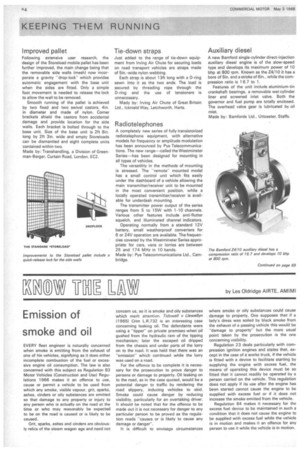by Les Oldridge AIRTE, AMIMI
Page 66

If you've noticed an error in this article please click here to report it so we can fix it.
Emission of smoke and oil
EVERY fleet engineer is naturally concerned when smoke is emitting from the exhaust of one of his vehicles, signifying as it does either incomplete combustion of the fuel or excessive engine oil consumption. The law is also concerned with this subject as Regulation 83 Motor Vehicles (Construction and Use) Regulations 1966 makes it an offence to use, cause or permit a vehicle to be used from which any smoke, visible vapour, grit, sparks, ashes, cinders or oily substances are emitted so that damage to any property or injury to any person who is actually on the road at the time or who may reasonably be expected to be on the road is caused or is likely to be caused.
Grit, sparks, ashes and cinders are obviously relics of the steam wagon age and need not concern us, so it is smoke and oily substances which merit attention. Tidswell v Llewellyn (19651 Crim L.R.732 is an interesting case concerning leaking oil. The defendants were using a "tipper" on private premises when pil gushed from the hydraulic ram of the tipping mechanism: later the escaped oil dripped from the chassis and under parts of the lorry on to the road. It was held that there was an "emission" which continued while the lorry was used on a road.
For the offence to be complete it is necessary for the prosecution to prove danger to persons or damage to property. Oil leaking on to the road, as in the case quoted, would be a potential danger to traffic by rendering the road slippery, inducing vehicles to skid. Smoke could cause danger by reducing visibility, particularly for an overtaking driver. It should be noted that for the offence to be made out it is not necessary for danger to any particular person to be proved as the regulation reads "causes or is likely to cause any damage or danger-.
It is difficult to envisage circumstances
where smoke or oily substances could cause damage to property. One supposes that if a lady's dress was soiled by black smoke from the exhaust of a passing vehicle this would be "damage to propertybut the more usual point taken by the prosecution is the one concerning visibility.
Regulation 23 deals particularly with compression ignition engines and states that, except in the case of a works truck, if the vehicle is fitted with a device to facilitate starting by supplying the engine with excess fuel, the means of operating this device must be so fitted that it cannot readily be operated by a person carried on the vehicle. This regulation does not apply if its use after the engine has been started cannot cause the engine to be supplied with excess fuel or if it does not increase the smoke emitted from the vehicle.
Regulation 84 makes it necessary for the excess fuel device to be maintained in such a condition that it does not cause the engine to be supplied with excess fuel while the vehicle is in motion and makes it an offence for any person to use it while the vehicle is in motion.




































































































































































































































